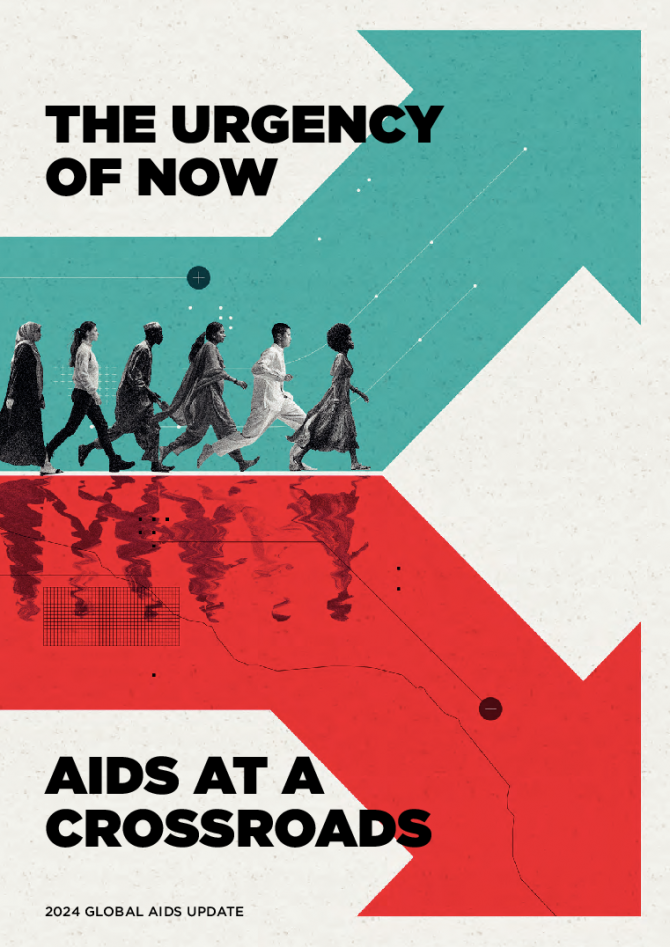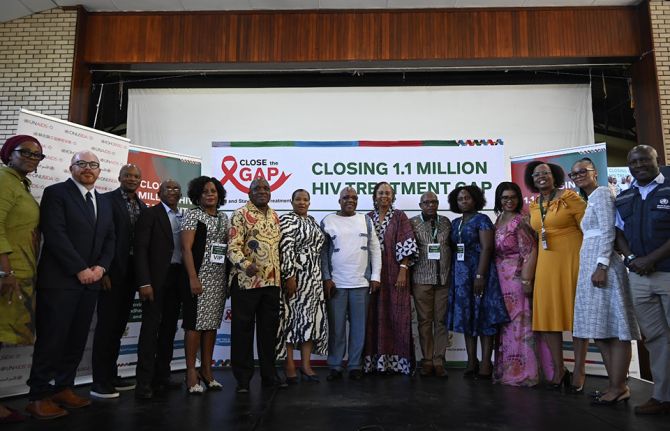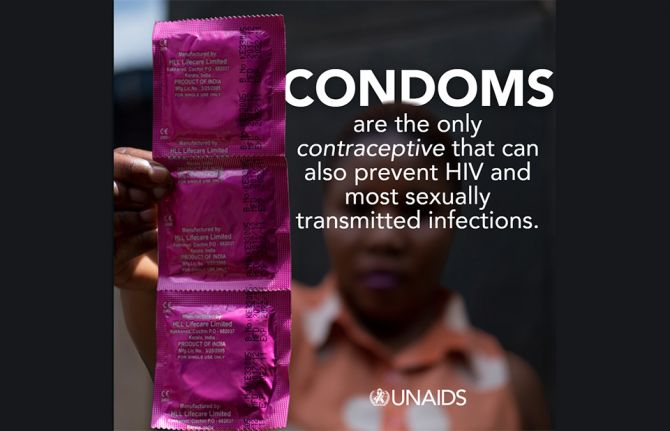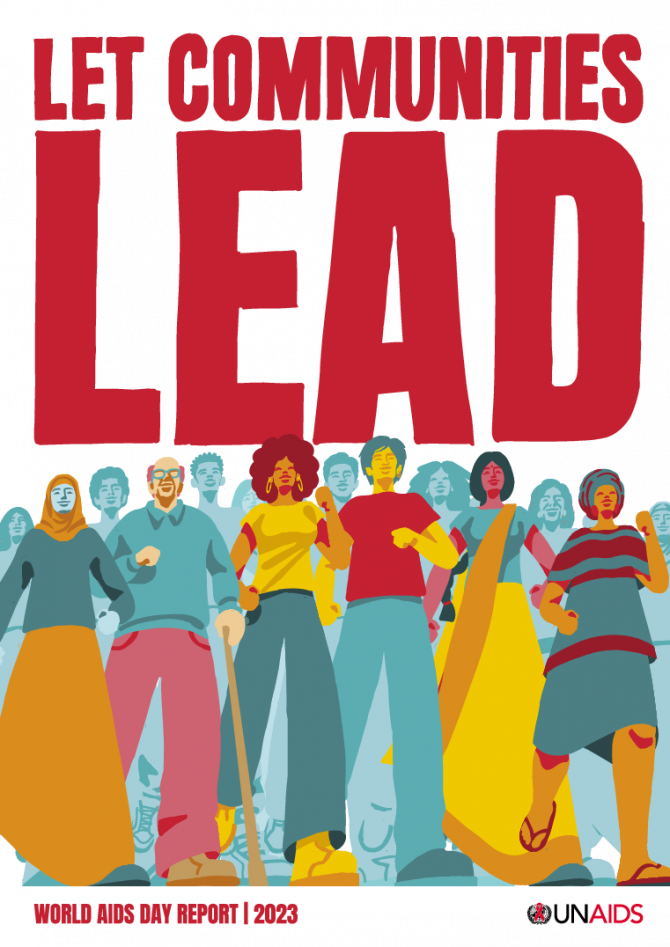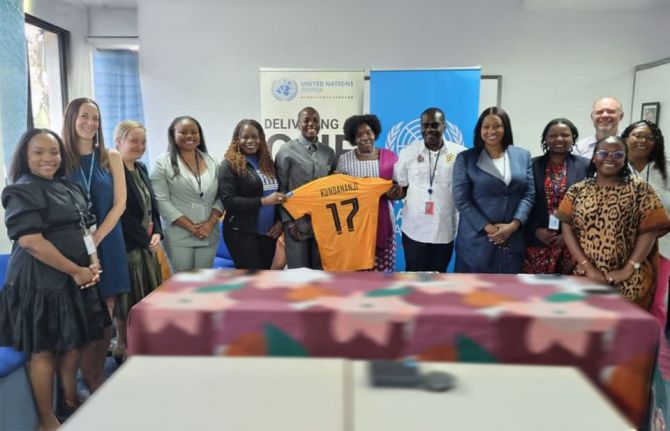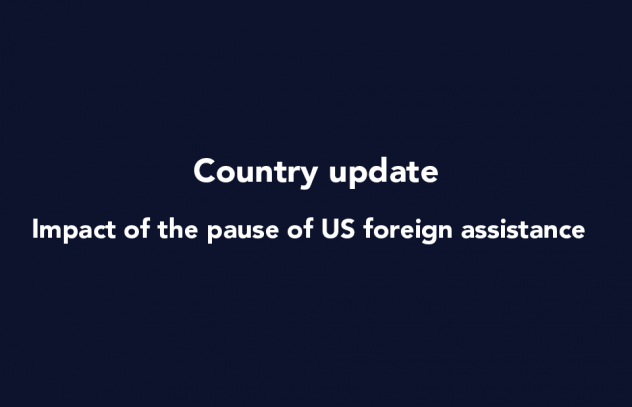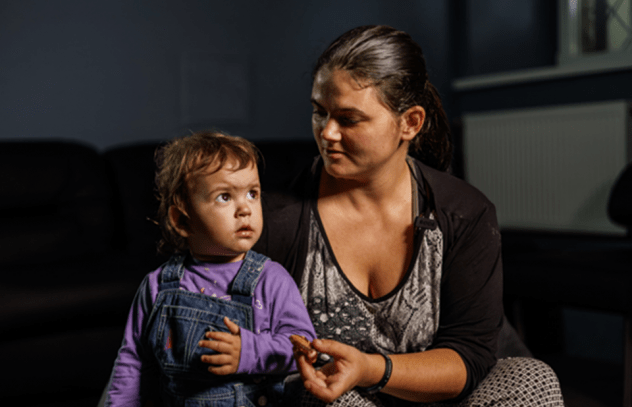Civil society
Documents
2024 global AIDS report — The Urgency of Now: AIDS at a Crossroads
22 July 2024
This UNAIDS 2024 report brings together new data and case studies which demonstrate that the decisions and policy choices taken by world leaders this year will decide the fate of millions of lives and whether the world’s deadliest pandemic is overcome. Related links: Press release | Special web site | Executive summary | Fact sheet | Video playlist | Epidemiology slides | Data on HIV | Annex 2: Methods Regional profiles: Asia and the Pacific | Caribbean | Eastern Europe and Central Asia | Eastern and Southern Africa| Latin America | Middle East and North Africa | Western and Central Africa | Western and Central Europe and North America Thematic briefing notes: People living with HIV | Gay men and other men who have sex with men | Transgender people | Sex workers | People who inject drugs | People in prisons and other closed settings | Adolescent girls and young women | Other translations: German
Related
 U=U can help end HIV stigma and discrimination. Here’s how
U=U can help end HIV stigma and discrimination. Here’s how

27 February 2025
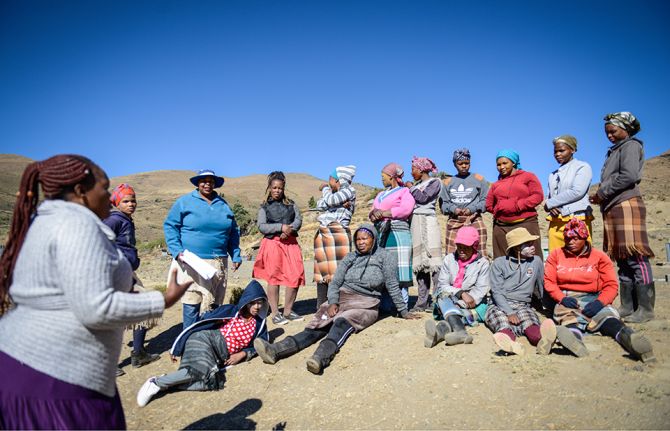 How the shift in US funding is threatening both the lives of people affected by HIV and the community groups supporting them
How the shift in US funding is threatening both the lives of people affected by HIV and the community groups supporting them

18 February 2025
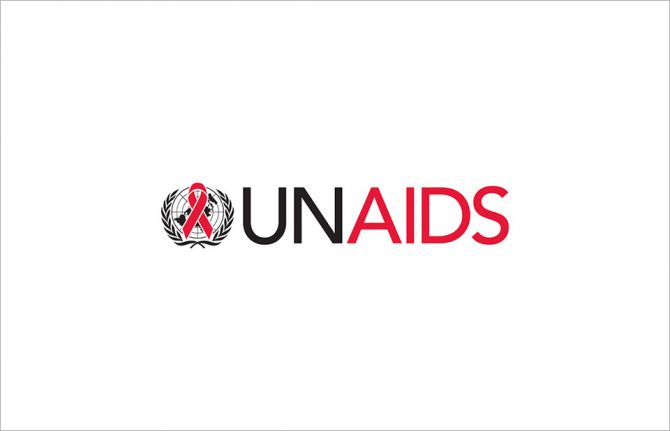 UNAIDS urges that all essential HIV services must continue while U.S. pauses its funding for foreign aid
UNAIDS urges that all essential HIV services must continue while U.S. pauses its funding for foreign aid

01 February 2025
Documents
Summary — Let Communities Lead — UNAIDS World AIDS Day report 2023
28 November 2023
This report is not only a celebration of the critical role of communities. It is a call to action to decision-makers to fully support the life-saving work of communities and to clear away the barriers that stand in their way. Press release | Full report | Fact sheet | World AIDS Day 2023
Related
 UNAIDS calls for rights, equality and empowerment for all women and girls on International Women’s Day
UNAIDS calls for rights, equality and empowerment for all women and girls on International Women’s Day

06 March 2025
 U=U can help end HIV stigma and discrimination. Here’s how
U=U can help end HIV stigma and discrimination. Here’s how

27 February 2025
 How the shift in US funding is threatening both the lives of people affected by HIV and the community groups supporting them
How the shift in US funding is threatening both the lives of people affected by HIV and the community groups supporting them

18 February 2025

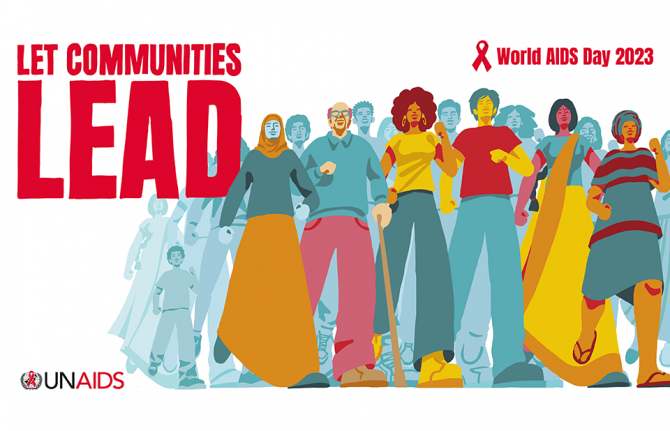
Press Release
Ahead of World AIDS Day UNAIDS is calling for urgent support to Let Communities Lead in the fight to end AIDS
30 November 2023 30 November 2023A new report by UNAIDS demonstrates the critical role communities play, and how underfunding and harmful barriers are holding back their lifesaving work and obstructing the end of AIDS.
LONDON/GENEVA, 28 November 2023—As World AIDS Day (1 December) approaches, UNAIDS is urging governments across the world to unleash the power of grassroots communities across the world to lead the fight to end AIDS. A new report launched today by UNAIDS, Let Communities Lead, shows that AIDS can be ended as a public health threat by 2030, but only if communities on the frontlines get the full support they need from governments and donors.
“Communities across the world have shown that they are ready, willing and able to lead the way. But they need the barriers obstructing their work to be pulled down, and they need to be properly resourced,” said Winnie Byanyima, Executive Director of UNAIDS. “Too often, communities are treated by decision-makers as problems to be managed, instead of being recognised and supported as leaders. Communities are not in the way, they light the way to the end of AIDS.”
The report, launched in London during a World AIDS Day event organized by the civil society organization STOPAIDS, shows how communities have been the driving force for progress.
Community advocacy from the streets to the courtrooms to parliaments has secured groundbreaking changes in policy. Communities’ campaigning helped open up access to generic HIV medicines, leading to sharp, sustained reductions in the cost of treatment from US$ 25 000 per person per year in 1995 to less than US$ 70 in many countries most affected by HIV today.
Let Communities Lead shows that investing in community-led HIV programmes delivers transformational benefits. It sets out how programmes delivered by community-based organizations in Nigeria were associated with a 64% increase in access to HIV treatment, a doubling of the likelihood of HIV prevention service utilization, and a four-fold increase in consistent condom use among people at risk of HIV. It also notes how, among sex workers reached by a package of peer-based services in the United Republic of Tanzania, the HIV incidence rate was reduced to below half (5% vs 10.4%).
“We are the vehicle for change that can end systematic injustices that continue to fuel HIV transmission. We have seen groundbreaking developments with U=U, improved access to medicines, and have made great strides in decriminalisation," said Robbie Lawlor, Co-Founder of Access to Medicines Ireland. “Yet, we are expected to move mountains without being financially supported. We are supposed to fight for a more equitable world and are tasked with dismantling stigma yet are side-lined in crucial discussions. We are at a tipping point. Communities can no longer be relegated to the periphery. The time for leadership is now.”
The report highlights how communities are at the forefront of innovation. In Windhoek, Namibia, a self-funded project by the youth Empowerment Group is using e-bikes to deliver HIV medicines, food and adherence support to young people who often cannot attend clinics due to their schooling hours. In China, community organizations developed smartphone apps that link people to self-testing which contributed to a more than four-fold increase in HIV tests across the country from 2009 to 2020.
The report reveals how communities are also holding service providers to account. In South Africa five community networks of people living with HIV inspected 400 sites across 29 districts and conducted more than 33 000 interviews with people living with HIV. In the Free State province, these findings led provincial health officials to implement new appointment protocols to reduce clinic wait times and three- and six-month dispensing of antiretroviral medicines.
“I am extremely concerned about the exclusion from health services of key populations like the LGBT+ community,” said Andrew Mitchell, Minister of State for Development and Africa. “The UK champions the rights of such communities, and we will continue to protect them, working closely with our partners in civil society. I thank UNAIDS for keeping us focused on the inequities driving the pandemic and I look forward to working with our partners to champion the voice of people living with HIV and end AIDS as a public health threat by 2030.”
Despite the clear evidence of community-led impact, community-led responses are unrecognized, under-resourced and in some places even under attack. Crackdowns on civil society and on the human rights of marginalized communities are obstructing communities from providing HIV prevention and treatment services. Underfunding of community-led initiatives is leaving them struggling to continue operating and holding them back from expansion. If these obstacles are removed, community-led organizations can add even greater impetus to end AIDS.
In the 2021 Political Declaration on ending AIDS, United Nations member states recognized the critical role communities play in HIV service delivery, particularly to people most at risk of HIV. However, whereas in 2012, when over 31% of HIV funding was channelled through civil society organizations, ten years later, in 2021, only 20% of funding for HIV was available—an unprecedented backsliding in commitments which has cost and is continuing to cost lives.
“At this time, community-led action is the most important countermeasure in the AIDS response,” said Solange Baptiste, Executive Director of the International Treatment Preparedness Coalition. “Yet, shockingly, it isn’t a cornerstone of global plans, agendas, strategies, or financing mechanisms for improving pandemic preparedness and health for all. It is time to change that.”
Every minute, a life is lost to AIDS. Every week, 4000 girls and young women become infected with HIV, and out of the 39 million people living with HIV, 9.2 million do not have access to lifesaving treatment. There is a Path that Ends AIDS and AIDS can be ended by 2030, but only if communities lead.
UNAIDS is calling for: Communities’ leadership roles to be made core in all HIV plans and programmes; Communities’ leadership roles to be fully and reliably funded; And for barriers to communities’ leadership roles to be removed.
The report features nine guest essays from community leaders, in which they share their experience on the achievements they have secured, the barriers they face, and what the world needs to end AIDS as a public health threat.
UNAIDS
The Joint United Nations Programme on HIV/AIDS (UNAIDS) leads and inspires the world to achieve its shared vision of zero new HIV infections, zero discrimination and zero AIDS-related deaths. UNAIDS unites the efforts of 11 UN organizations—UNHCR, UNICEF, WFP, UNDP, UNFPA, UNODC, UN Women, ILO, UNESCO, WHO and the World Bank—and works closely with global and national partners towards ending the AIDS epidemic by 2030 as part of the Sustainable Development Goals. Learn more at unaids.org and connect with us on Facebook, Twitter, Instagram and YouTube.
Contact
UNAIDS GenevaSophie Barton Knott
tel. +41 79 514 6896
bartonknotts@unaids.org
UNAIDS Media
communications@unaids.org
UNAIDS Geneva
Michael Hollingdale
tel. +41 79 500 2119
hollingdalem@unaids.org
World AIDS Day message
World AIDS Day 2023
Watch the launch
World AIDS Day report
World AIDS Day videos

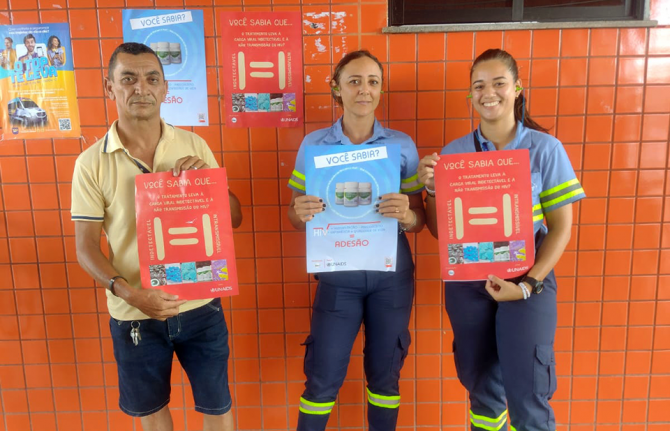
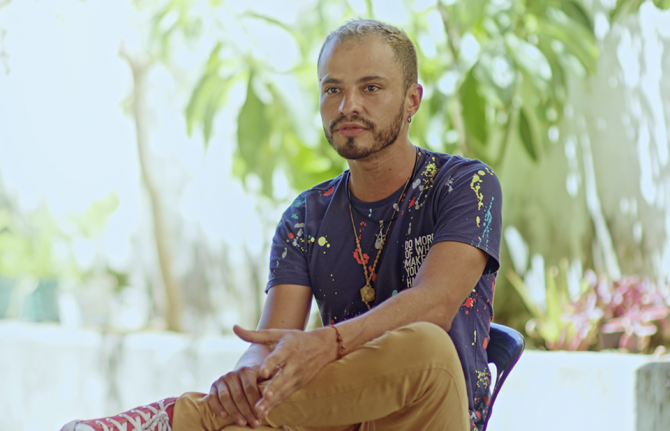
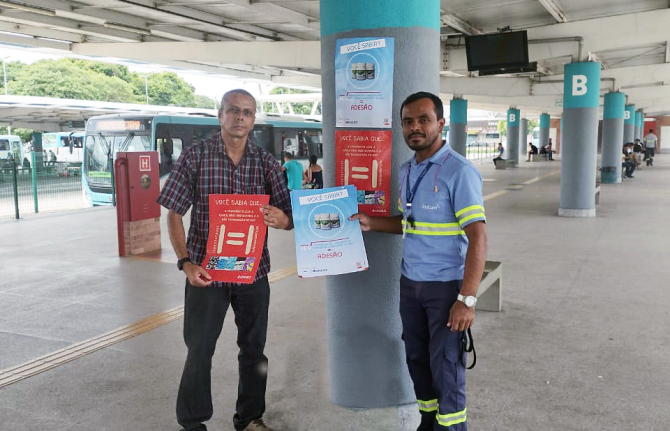
Feature Story
In Northeast Brazil, civil society and local government collaborate to increase HIV treatment adherence
03 April 2023
03 April 2023 03 April 2023In 1988, a group of activists came together in Fortaleza, the fifth largest city in Brazil and capital of Northeastern state of Ceará, to create the local chapter of the National Network of People Living with HIV and AIDS (RNP+CE). The aim was to ensure that people living with HIV could be guaranteed the right to care, treatment adherence, and legal assistance.
Currently, the NGO (Non-Government Organizations) also offers educational workshops, support for the combination prevention of sexually transmitted infections (STIs), and other activities for more than 1,000 registered people. Among them is Carlos Salmão, an HIV activist living in Fortaleza, who felt individually and collectively welcomed by the organization. "This support was very important to me and is fundamental for people living with HIV here in Ceará because it is a reference of the response to the AIDS epidemic. That is why I feel pleasure in contributing", he explains.
The RNP+CE was one of five Brazilian NGOs that received resources from the Fast-track Cities grants initiative, launched by UNAIDS in 2022. With the award, the organization developed actions around two objectives: increasing linkage and adherence of vulnerable key-populations to HIV prevention, diagnosis, and treatment by disseminating and sharing information with health professionals as well as the general public; and improving the knowledge of the Undetectable Equals Untransmittable (U = U) strategy in the city of Fortaleza by carrying out communication campaigns.
Project actions and participation of municipal government
The project involved 10 local HIV-positive activists in the development and implementation of the communication campaigns. They also were involved in preparing a seminar that brought together 120 people from civil society to dialogue about and to present to municipal government representatives proposals to improve the care for people living with HIV, based on the perspectives and actual needs of the users of public health services in Fortaleza. An additional theme of discussion was the challenges and the importance of guaranteeing a satisfactory level of adherence to HIV treatment to avoid abandonment.
Still as part of the project, a booklet on HIV, self-esteem and health was produced and distributed, providing practical information for people who receive a positive diagnosis for HIV. Additionally, in coordination with the municipal government, RNP + CE printed and distributed more than 3,000 copies of posters on HIV treatment adherence and on U = U. This material was displayed in places with high concentrations of people, such as bus terminals, reaching about 1.1 million people daily.
Participation of local government officials was a strategic element to the project’s success, as they are in direct contact with reality and the existing challenges. "We are still far from reaching an ideal level where there is less need to reinforce these [HIV] actions, but we are advancing in this direction through constant and well-structured work", says Carlos Paiva, coordinator of IST/AIDS at the Municipal Health Secretariat of Fortaleza.
Ariadne Ribeiro, UNAIDS Officer for Equality and Rights for All People, agrees and adds: "It is rewarding to see how the dialogue between communities, civil society, and the municipal government is moving towards a common goal, which is the improvement of public policies in the city of Fortaleza for people living with HIV and to end AIDS as a threat to public health."
Related

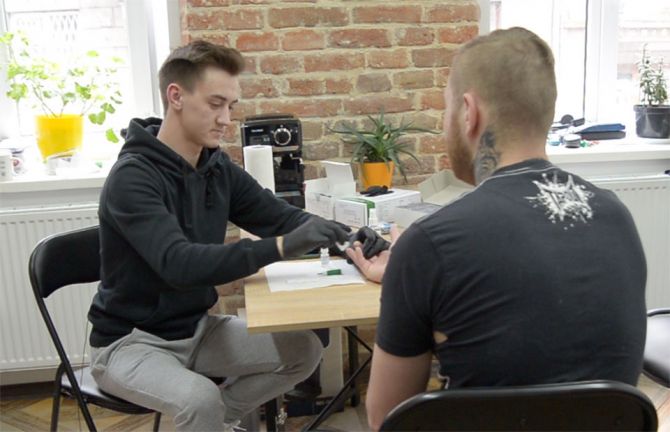
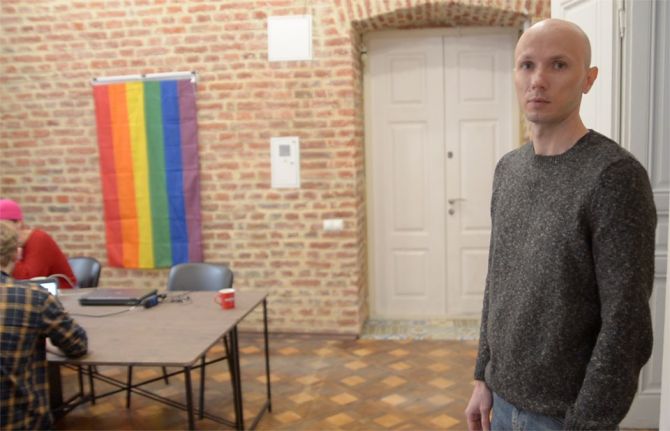
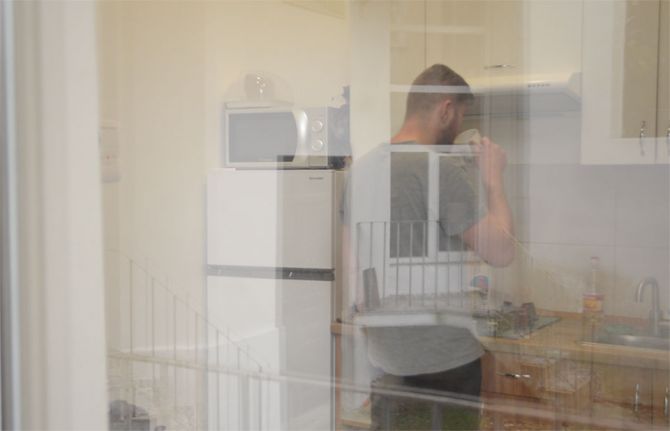
Feature Story
LGBTQ+ shelter in Lviv provides lifeline to displaced Ukrainians
27 February 2023
27 February 2023 27 February 2023Oleg Kucherenko (not his real name) traveled from the eastern part of Ukraine to Lviv, in the western part of the country when his city, Kherson, was occupied by Russian forces. He, like many other representatives of the LGBTQ+ community was desperately looking for a safe place to stay.
His friend recommended the Facebook group of the Alliance Global - the largest LGBTQ+ organisation in Ukraine, who helped him find a spot in a shelter.
Once there, he got food, a place to sleep, and was able to contact friends and colleagues courtesy of electric generators and internet service. Up to ten people can stay in this particular shelter. The shelter administrator, Vadim Pryzenko, sees this as a lifeline.
“Our clients can get not only a place to live but also food and social and psychological support,” he said. “For those who are not living here, we provide humanitarian aid, food, hygienic products, and also individual financial support,” Mr Pryzenko said.
Since the war began a year ago, more than 7.9 million Ukrainians have fled abroad and another 6.5 million moved within the country.
Due to growing demand to find accommodation for internally displaced people that Alliance Global experienced, several organizations, including the Fondation de France, International Office of Migration (IOM) and UNAIDS’ Emergency Ukraine Fund, helped them set up the shelter. The shelter also provides health care and HIV services.
Mr Kucherenko got tested for HIV, hepatitis, and other diseases. His HIV test came back positive. He quickly met with a social worker, Andriy Kharatin, who accompanied him to the Lviv AIDS center where he got confirmation of his diagnosis, and additional tests.
"Several days later, with our help connecting him with to the health care system, Oleg started anti-retroviral therapy,” Mr Kharatin said.
Ukraine has the second - after the Russian Federation- biggest HIV epidemic in Eastern Europe and Central Asia (240 000 people are living with HIV according to 2022 estimates).
The country was making good progress in the AIDS response before the war – increasing the number of people living with HIV on antiretroviral treatment to nearly 60%.
However due to their destruction or occupation, more than 30 medical institutions providing HIV services have had to stop their operations, and logistics and supply chains have been broken. Despite this, Ukraine continues to help people living with HIV. Civil society has played a crucial role in adapting their response, engaging and reaching people in need.
“As a doctor, I am very pleased with the cooperation with Alliance Global,” said Dr. Olena Pavlishina from the Lviv Clinical Hospital. “Thanks to this cooperation we have the opportunity to be in touch with both internally displaced people and people who do not trust doctors much.”
In the past, she explains, a lot of the work was handled by health professionals.
“This part of the work that was previously done by health workers is now being done by social workers and civil society organisations,” she said.
And Mr Pryzenko doesn’t imagine that changing in the near future. He fears that if the war drags on, more people will come to the shelter and need services.
Meanwhile, Mr Kucherenko lives and works in Lutsk, not far from Lviv. He picks up his HIV medicine supply for three months and will get his next batch by mail when needed. He also stays in touch with his social worker for psychological support online.
Region/country

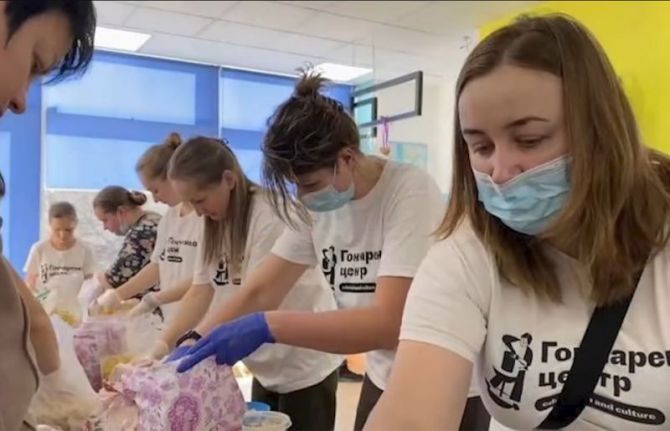
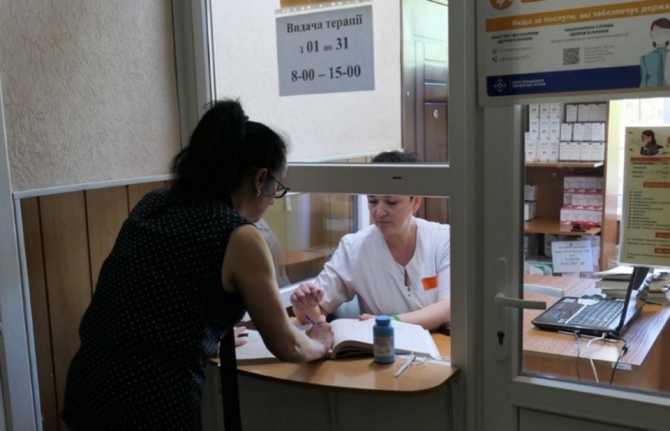
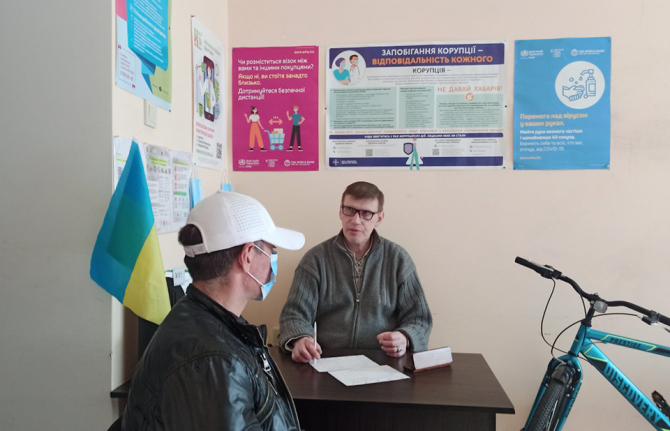
Press Statement
One year on: We must sustain the HIV response in Ukraine
23 February 2023 23 February 2023One year on, the war in Ukraine continues to inflict massive suffering and destruction. Since the start of the war on 24 February 2022, more than 13.5 million people have been internally displaced or forced to flee to neighboring countries as refugees, including people living with HIV and key populations.
Ukraine, the country with the second-largest AIDS epidemic in the Eastern Europe and Central Asia region, has been hit hard by the war.
The country was making strong progress in the AIDS response by: 1) increasing the number of people living with HIV on life-saving medicine (more than 150 000 people are on treatment out of 240 000 living with HIV); 2) working hand in hand with community-based organisations and 3) reaching full state financing of innovative HIV prevention services among key populations.
The shock of the war pushed all stakeholders to protect those precious gains.
The government of Ukraine and civil society partners have received enough anti-retroviral therapy (ARV), tuberculosis medicine, and opioid substitution therapy (OST) to provide uninterrupted treatment for everyone with the support of the Global Fund to Fight AIDS, Tuberculosis and Malaria, the United States President’s Emergency Plan for AIDS Relief (PEPFAR), UNAIDS, and other partners.
Civil society has been the engine of the national HIV response along with the Ukrainian Public Health Centre before the war and throughout the year. They have delivered services, medicines, and humanitarian aid to those in need without fail despite bombings, attacks, lack of electricity and reduced access to the east and south of the country.
This effort needs our ongoing support and funding. We cannot let Ukraine’s HIV response fall back.
UN agencies and partners on the ground have been working closely with local authorities to reach and help people in need. More recently they have delivered humanitarian assistance to hard hit territories in the country that have only now become accessible.
“Delivering essential aid and assistance relies on collaboration,” said Winnie Byanyima, UNAIDS Executive Director. “A coalition of government, civil society and international organisations has been and continues to be a cornerstone of the effective HIV response in Ukraine during the war. UNAIDS stands in solidarity with all the people and our partners working so hard on the frontlines.”
A UNAIDS Emergency Fund has enabled partners across the country to sustain HIV care and support services, as well as providing direct humanitarian assistance and targeted support to the most vulnerable. This has meant, for example, creating dozens of shelters for internally displaced persons, including people who use drugs, LGBTIQ+ people, and other key populations linking HIV service providers with available humanitarian assistance programmes. The Fund has received support from the Red Cross Monaco, the United States of America and Germany.
With further funding from Germany, civil society organizations in Moldova, Poland, and other neighboring countries united their efforts to improve access to services for Ukrainian refugees living with HIV.
UNAIDS has issued an urgent call to the international community for additional funding for civil society organisations to keep providing essential HIV support services in Ukraine and in countries receiving refugees in need of HIV services.
UNAIDS will continue to support HIV prevention, testing, treatment, care and support for people across Ukraine affected by the war and people displaced by the conflict.
UNAIDS
The Joint United Nations Programme on HIV/AIDS (UNAIDS) leads and inspires the world to achieve its shared vision of zero new HIV infections, zero discrimination and zero AIDS-related deaths. UNAIDS unites the efforts of 11 UN organizations—UNHCR, UNICEF, WFP, UNDP, UNFPA, UNODC, UN Women, ILO, UNESCO, WHO and the World Bank—and works closely with global and national partners towards ending the AIDS epidemic by 2030 as part of the Sustainable Development Goals. Learn more at unaids.org and connect with us on Facebook, Twitter, Instagram and YouTube.
Key humanitarian messages
War in Ukraine and the HIV response
Region/country

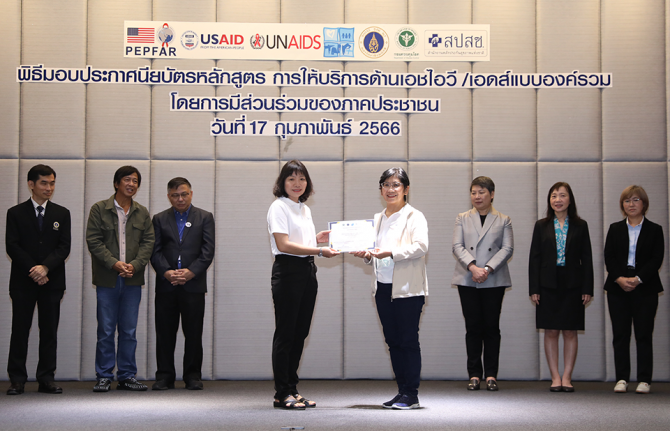
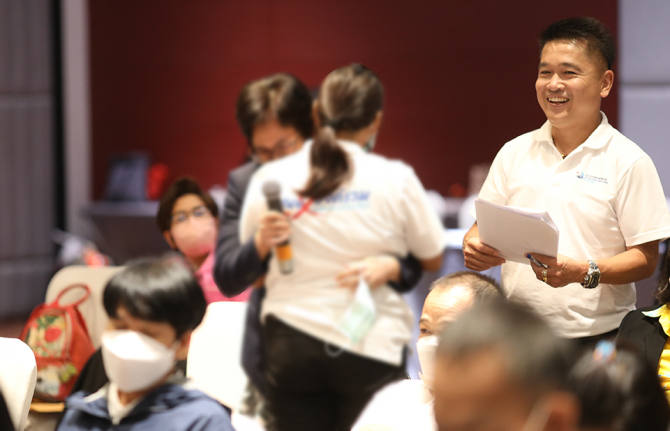
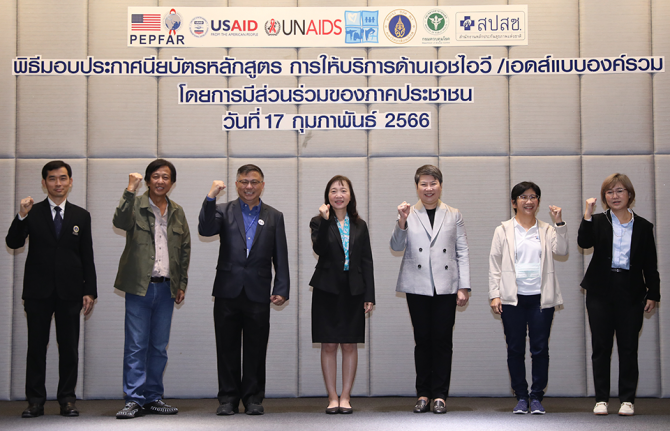
Feature Story
Thailand partners develop community-led HIV care curriculum
23 February 2023
23 February 2023 23 February 2023For 20 years Kochaphan Wangtan has been a community health worker, serving other people living with HIV (PLHIV) in Thailand.
“I’ve seen many friends living with HIV come to care very late with opportunistic infections,” she said.
“I focus on helping to bring them in and provide support to start antiretroviral treatment right away and I also conduct home visits, counselling and psychosocial screening so I can link them to services they need,” Ms Wangtan explained.
Ms Wangtan is from the Jai-Prasan-Jai Comprehensive Continuum of Care Center (CCC) from the Phan District Hospital in Chiang Rai province. She is one of almost one thousand PLHIV health workers who are embedded in more than 230 Thai hospitals and serve almost 60,000 PLHIV annually.
For the first time, the country has rolled out a national community health worker certification for these volunteers. The initiative is called “A Comprehensive Continuum of HIV/AIDS Care and Support for and by People living with HIV.” The curriculum was developed by the Ratchasuda College of the Mahidol University through close collaboration with the Thai Network of People Living with HIV/AIDS (TNP+) as well as support from the Health Ministry’s Division of AIDS and STIs and the National Health Security Office. USAID-PEPFAR via the III Unify Collaboration Programme and UNAIDS provided technical and financial support.
“PLHIV volunteers have provided the first community engagement in the HIV response since the start of the epidemic in Thailand,” said UNAIDS Country Director, Patchara Benjarattanaporn. “Peer-led support boosts treatment initiation and retention and is central to the HIV response,” she said. This initiative ensures that PLHIV-led health services are standardized, recognized and valued.
Two modules are delivered over 90 hours. The first module focuses on theoretical training, including on holistic follow-up care, treatment adherence counselling and developing a comprehensive service plan. The second module is practical. Along with its HIV focus, the curriculum also integrates tuberculosis, sexually transmitted infections, Hepatitis C and non-communicable diseases. Earlier in the month the first cohort of 46 PLHIV health workers received their certification.
Dr. Wachara Riewpaiboon, a rehabilitation physician and former Ratchasuda College Dean, developed the curriculum.
“The health system is not only for health professionals… It belongs to everyone,” she said. “Getting an HIV diagnosis does not help clients understand what they are facing. When people living with HIV tell their story, it is very different knowledge they are imparting. The knowledge that helps people make decisions for themselves usually comes from peers, not doctors.”
For her, care goes beyond medicine.
“It is not only biology that we are dealing with, but also psychology and our interaction with our social environment—how people look at people living with HIV and how they perceive themselves,” Dr Riewpaiboon continued. “It is very important to help people see the positive side of their experience.”
According to Nurse Chulaporn SingPae, an HIV Coordinator at the Phan District Hospital, PLHIV volunteers help with counselling, adherence, missed appointment follow-up, home visits, treatment deliveries, overcoming stigma including self-stigma and promoting understanding of U=U, undetectable equals untransmittable. (An undetectable viral load means the virus is not transmittable aka untransmittable.) The training ensures that these contributions are recognized by the health system as meeting quality standards.
Now that the course has been developed and tested, the curriculum has been recognized by the National Health Security Office (NHSO). Thai civil society organizations, who provide HIV and STI services with certified community health workers have been accredited and are eligible to register as health service units in the Universal Health Coverage scheme. Having supported the development and pilot of the curriculum, UNAIDS is now supporting a study to cost these services. The office is also working to promote sufficient and sustainable financing for community-led health services for PLHIV and key populations.
“This training is going to become the guarantee that a peer educator provides a high quality of service, in a holistic way, which encompasses not just the physical but also the mental, emotional and social aspects,” said Apiwat Kwangkeaw, Chairperson of the Thai Network of People living with HIV/AIDS. “As this becomes institutionalized, we are sending a message to the health system as a whole to let the community of peer educators be an equal partner,” he said. Mr Kwangkeaw hopes this will translate into sustainable domestic financing for community-led health services and better quality of life for PLHIV.
Region/country
Related

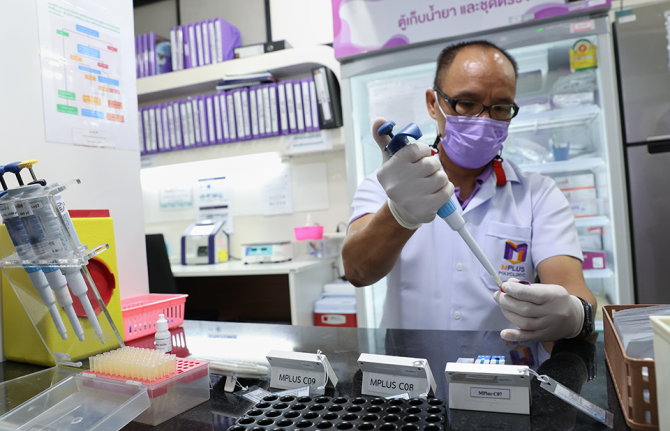
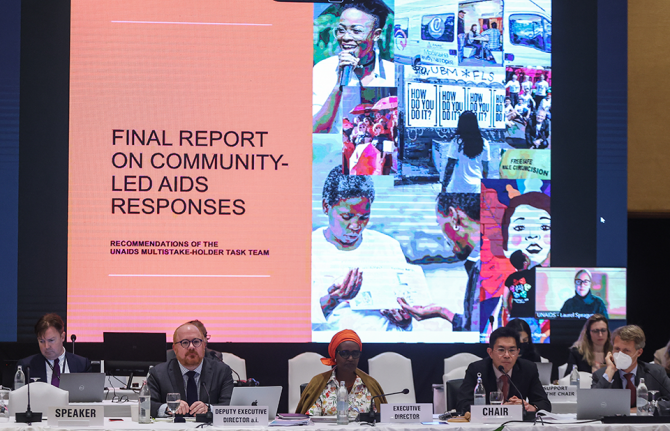
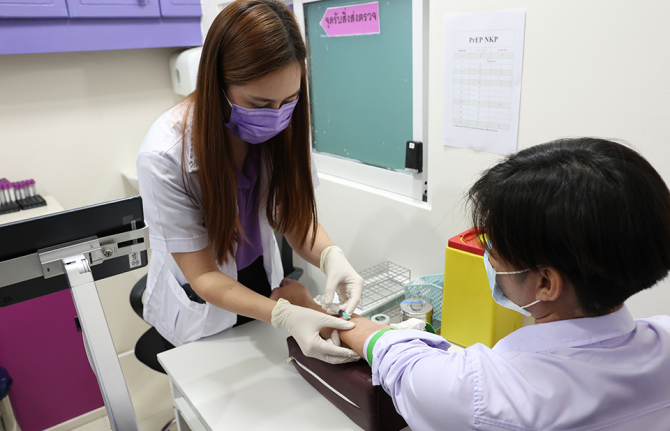
Press Release
Pandemics can only be defeated if communities are supported to lead, say governments, NGOs and UN
15 December 2022 15 December 2022CHIANG MAI, THAILAND, 15 December 2022—Community-led responses are a critical part of the AIDS pandemic response, and must be prioritised in resourcing. The approach, set out by governments, civil society organisations and United Nations agencies at an international meeting on AIDS in Chiang Mai, Thailand, will also be key for tackling other pandemics and for preparing for the pandemics to come, delegates said. The meeting saw the first international definition of a community-led response to a pandemic, published after a two-year consultative process that brought together 11 governments, representing each region of the world, and 11 civil society representatives. This UNAIDS multi-stakeholder task team on community-led responses was co-convened by the World Health Organization and United Nations Development Programme, and presented outcomes to the 51st Programme Coordinating Board meeting of the UN Joint Programme on HIV and AIDS.
Using the new definitions and recommendations, German Federal Health Minister Prof. Karl Lauterbach and the UNAIDS Executive Director Winnie Byanyima published an article in The Lancet today calling for inclusion of comprehensive “community pandemic infrastructure” in pandemic prevention, preparedness and response in new planning, international agreements, and financing. In it, the leaders show that strong community infrastructure, working synergistically with government, is a necessary but neglected element of effective pandemic prevention, preparedness, and response. Using evidence from AIDS, mpox, COVID-19, and Ebola, the authors describe how community-led organisations bring trust, communications channels, and reach to marginalised groups that complement government roles and improve equity.
The new international definitions and recommendations can help planners and funders for AIDS and other pandemics identify the elements of an effective community response. Community-led organizations, defined as "groups and networks, whether formally or informally organized ... for which the majority of governance, leadership, staff, spokespeople, membership and volunteers, reflect and represent the experiences, perspectives, and voices of their constituencies and who have transparent mechanisms of accountability to their constituencies,” form a backbone of that response. Crucially, it is noted that "not all community-based organizations are community-led.”
"While what is most often understood as infrastructure – like labs and hospitals – are important, also essential to effective pandemic response is the community infrastructure which includes people to do outreach, trusted voices who can speak to excluded communities, independent accountability mechanisms, and participation in decision-making,” explained Dr Matthew Kavanagh, UNAIDS Deputy Executive a.i for Policy, Advocacy and Knowledge. “This task team of governments, civil society, and international organizations has given important new tools to support the building and monitoring of community-led capacity. We will only be able to end AIDS and stop other pandemics by ensuring that this community infrastructure is intentionally enabled, strengthened, monitored, and resourced.”
The United Nations Joint Programme on HIV/ AIDS (UNAIDS) Board meeting in Chiang Mai included dialogue between member states and non-state participants on how to develop laws and policies to facilitate community-led response. The recommendations of the multistakeholder task team include developing better systems for financing community-led organisations, which often face legal, capacity, and eligibility barriers to national and international financing mechanisms; monitoring community-led capacity; and integrating data generated by community groups into response management.
To end the AIDS pandemic, board members pointed out, community responses to HIV must be integrated into all levels of countries’ AIDS strategies including planning, budgeting, implementation, monitoring and evaluation.
The principles developed apply not only to AIDS. "Stopping COVID-19, mpox, and Ebola, and preparing for the next pandemic, all require that partnership of government and community together. The newly agreed framework for defining and measuring community-led responses make us better equipped to address the inequalities that are holding back progress in ending AIDS,” said Dr Kavanagh.
In Thailand, as delegates saw for themselves first hand, key-population-led health services have reached people at increased risk of HIV, achieving among the most equitable HIV responses in the region. In South Africa, community leaders with Ritshidze, which represents people living with HIV, visit clinics and communities to assess COVID-19, HIV, and tuberculosis services and hold administrators accountable for addressing issues such as long waiting times or confidentiality gaps that keep some people away from health services. Amid war, Ukraine’s 100% Life, a network of people living with HIV, has used peer networks to communicate with displaced people, delivering medicines, food, and emergency assistance.
"International pandemic agreements and funding should include specific goals for community-led capacity," said Dr Kavanagh. "To be effective, pandemic responses need to move beyond one-way communications to bring communities into decision making at all levels. Community leadership is not mere nice-to-have. It is essential for ending pandemics."
The Lancet article marking the occasion by the German Health Minister and the UNAIDS Executive Director is here.
The report presented at the UNAIDS Programme Coordinating Board meeting is here.
Resources on Community Led Pandemic Response are here.
UNAIDS
The Joint United Nations Programme on HIV/AIDS (UNAIDS) leads and inspires the world to achieve its shared vision of zero new HIV infections, zero discrimination and zero AIDS-related deaths. UNAIDS unites the efforts of 11 UN organizations—UNHCR, UNICEF, WFP, UNDP, UNFPA, UNODC, UN Women, ILO, UNESCO, WHO and the World Bank—and works closely with global and national partners towards ending the AIDS epidemic by 2030 as part of the Sustainable Development Goals. Learn more at unaids.org and connect with us on Facebook, Twitter, Instagram and YouTube.
Our work
Communities make the difference

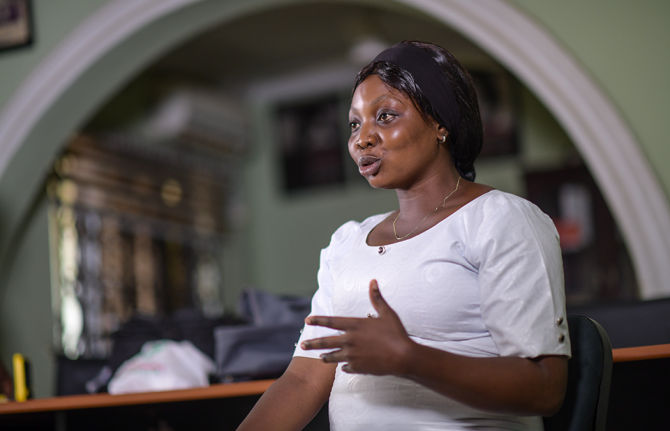
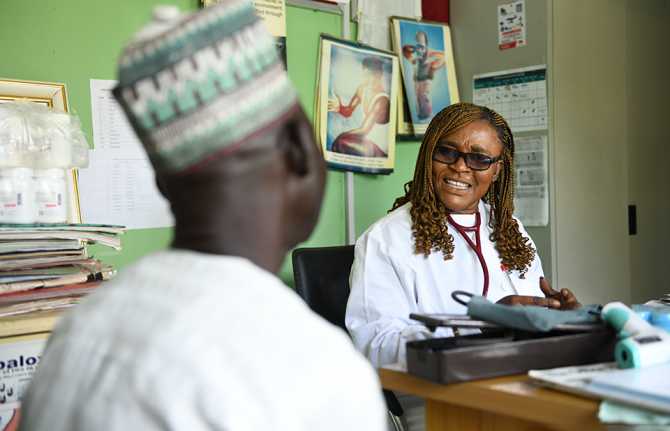
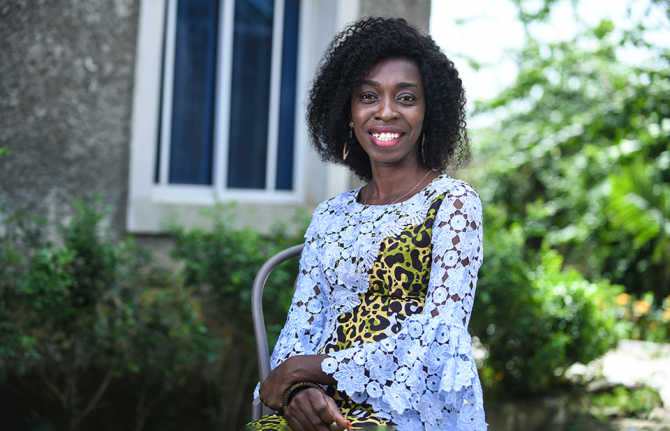
Feature Story
Dangerous inequalities and overcoming them
18 November 2022
18 November 2022 18 November 2022Grace Amodu was 7 years old when she found out she was living with HIV. Until then she had been told to take pills daily for malaria or for headaches but she grew tired of it. Screaming and kicking she told her brother that she was going to stop taking her medicine and that she wanted answers. Her mother took her aside and explained that she was born with HIV and that the treatment would keep her healthy like other kids.
She remembers crying a lot and refusing to leave the house.
To keep her from spiraling out of control her mom encouraged her to join a support group, which she says turned her life around.
As she proudly says she has two children who are both free of HIV. Taking her medication at the same time every day throughout her pregnancy and afterwards meant she was not going to transmit HIV to her babies. "When you take medicine it suppresses the virus and even though I feared my children may have HIV they both tested negative.”
She credits International Community of Women Living with HIV (ICW) Nigeria chapter for giving her hope and confidence.
“ICW was like a backbone, they were there for me like the colleagues, everyone around was standing for me, even the boss, Assumpta Reginald, was like a mother figure to me,” Ms Amodu said. “She held me by the hand telling me that, ‘You can do this and you can become a better person.’
As a result, Ms Amodu has become an HIV advocate and a community pharmacist.
"We go to the hospital and get medicine for people and give them to patients who are maybe not able to access their drugs because they have no transport fare or they are far away or due to the stigma in the hospital they don’t want to come to have nurses and doctors shout at them so we take these drugs down to their doorstep and give it to them,” she explained.
More than 90% of people living with HIV in Nigeria are on antiretroviral medicine but stigma and discrimination are still rampant.
For Ms Amodu the solution is simple. Give people the right information about HIV to break the cycle.
“We need to make people understand that you being HIV positive is not making you less of a human, you are also a human being and you deserve equal rights,” the 28-year-old said.
Stella Ebeh knows all about stigma. She started volunteering in 2004 helping people living with HIV like herself. Then she started working in a health center and became a public health officer. Over the years Ms Ebeh said she has cared for more than 7000 patients and also became a mentor-mother (giving HIV advice to pregnant women and counselling), and an anti-stigma ambassador.
She is very proud of overcoming stigma and as she called it, “walking on it,” but despairs that she is still not a full-time staff member. People living with HIV are very capable and yet we are often overlooked she said, adding, “I work like an elephant but eat like a rat.”
Patients pour in and out of the Marabara health centre on the outskirts of Abuja all day. Ms Ebeh goes from one person to another. She lingers a while with a pregnant woman who also prepares lunch on the premises, Ngozi Blessing.
Ms Ebeh insists on pregnant women taking all the precautions they can to give birth to healthy babies. Her husband and their five children are all HIV negative. Sadly, in Nigeria this is an exception.
Vertical transmission is 25% in the country - that is when a mother passes on the virus to her child during pregnancy or breastfeeding- a record high in the region.
UNAIDS Country Director Leopold Zekeng says this is unacceptable. For him it is a demonstration of the inequalities in terms of access to services.
“Two thirds of the 8 million women who get pregnant every year in Nigeria do not have access to PMTCT (prevention between mother to child transmission of HIV) services during ante-natal care,” he said.
This is why Nigeria and UN organizations along with other partners are spearheading an effort to end AIDS in children.
Dr Akudo Ikpeazu, Director and National Coordinator, National AIDS and STDs Control Programme (NASCP) said that in the last 2 years they have done an enormous amount of work first trying to get a mapping to understand where all the women are having babies and where they receive ante-natal care if at all.
“A lot of them are in birth homes, they go to traditional birth attendants and many deliver at home and receive services at home and so we have a got new strategy which aims to find them where they are, ensure that they are treated, ensure that we can find them first, ensure that we can test them, link them into treatment and count every single one that has gained access to care,” she said.
In other words, find all, test all, treat all and report all which happens to be Nigeria’s slogan encapsulating their strategy.
Once that vertical transmission tap, as she called it, is closed, then there will be a smaller pool of children to look after regarding treatment. Dr Ikpeazu said Nigeria intends to put in place an acceleration plan to have more children and adolescents on treatment and push for them to stay on treatment.
For Toyin Chukwuduzie, Director of Education as a Vaccine (EVA), HIV is one part of a larger equation.
“We see the number of unintended pregnancies, we see the burden of HIV especially among adolescent girls, we also see the sexual and gender based violence happening in our society so these things are in existence, these things are happening, yet adolescents and young people don’t have the information they need to make decisions whether we are talking about schools, whether we are talking about health facilities or even in the homes where there are other adults so there are huge gaps,” she said.
The 35-year-old works with young people to fill those education gaps and build support. She is convinced that a main driver of these gaping holes are inequalities, one in particular.
"I believe gender inequality is the root cause of many other inequalities so if had a magic wand gender inequality would be the one I would address the first because it’s key,” she said. “Addressing gender inequality is key to unlocking potential, potential of women and girls everywhere in this country.”
Hammering in her point, she added that despite everyone stressing the fact that young people are the force of the future Ms Chukwudize said, "If you are not providing that safe environment, if they are not healthy, if their dreams and aspirations are thrown off the path, how do they become the future that we want to see.”
Region/country
Related

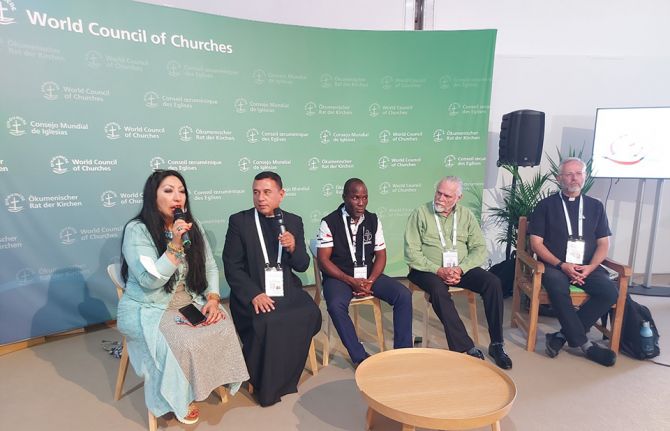
Feature Story
People living with HIV speak loudly and clearly at World Council of Churches Assembly
07 September 2022
07 September 2022 07 September 2022The 11th Assembly of the World Council of Churches (WCC) is meeting in Karlsruhe, Germany, from August 31 to September 8, 2022. The WCC brings together delegates and participants from 345 denominations from around the world, representing more than 500 million Christians.
Faith leaders and activists living with HIV expressed huge concerns for the future of the HIV response. Young people continue to be exposed to HIV; women are experiencing violence in all forms. Governments are moving away from HIV and many ecumenical organizations too.
What we need is a continued engagement with people with HIV and those at risk.
My country depends on international aid, what if we stop having that support?”, said one faith leader.
Another said, “Adolescents and children are not staying on medication, they are getting sick and some of them are dying”. Time is running out for the HIV response, we have to help people to live and stay safe and healthy.
People with HIV in the WCC Assembly are speakers and are leading plenaries, workshops and ecumenical conversations. They are bringing attention to the role of the church and the ecumenical movement to continue responding to the HIV epidemic; not only in relation to HIV stigma, but also in advocacy for a sustainable response to HIV, gender justice, human sexuality and the work on HIV related intersectionality and inequalities. This is a matter of justice, love and reconciliation.
The third thematic plenary Affirming the wholeness of life, included input from Canon Gideon Byamugisha from Uganda. He spoke about the realities of young people exposed to HIV and the consequences of unequal access to COVID-19 vaccines, because of unfair patent systems. He shared his experience of receiving support from Bishop Samuel Ssekkadde in 1998 who was leading the Anglican Church in Uganda and how that support saved his life when he was about to die without access to HIV medications. For many people with HIV, that continues to be a reality today.
Canon Gideon Byamugisha is one of the founders of INERELA+ (International Network of Religious Leaders Openly Living or Affected by HIV). He asked the Assembly participants to adopt the targets of the Global AIDS Strategy: the 95-95-95 strategy, which means that 95% of people living with HIV should be tested, 95% of those, should be on treatment and 95% of those, should have undetectable viral load, meaning that they can no longer transmit HIV and can stay healthy.
On September 2, five faith leaders openly living with HIV shared local experiences of churches responding to HIV stigma. In Argentina, some churches are taking care of transgender, indigenous women living with HIV; in Ghana, other churches are promoting the message of undetectable HIV = untransmitable HIV. In the United States, faith based organizations are providing affordable housing for people living with HIV who are transitioning out from rehabilitation or from the penitentiary system. Churches in Kenya are caring for children orphaned by HIV and they provide care and accompaniment for women who experienced sexual violence.
The workshop presented the results of a six-month case study recently completed by the WCC and Emory University. “We emphasize stigma because we know that it is a major driver of the HIV epidemic,” said Dr. David Barstow, one of the workshop organizers. “And we emphasize the role of local churches because of the influence they have on their members and on the rest of society. Local churches, indeed local communities of all faith traditions, are key to eliminating stigma and are therefore key to ending the epidemic.”
Some of the preliminary findings of the study refer to the role of people living with HIV who have a deeper understanding of stigma because of their lived experience. According to Professor John Blevins, who led the case study team, “…in the case study, when people living with HIV talk about stigma, they describe complexities that are often not apparent to people who do not live with HIV”
One faith leader said that “…despite my congregation’s commitment to stigma reduction, many people with HIV still feel uncomfortable disclosing our status.” The stigma was perceived as something that comes from those “on top” in the church. Another faith leader said, “Every time one of them dies, I die a little bit myself.”
The church and faith communities have much work to do in relation to HIV stigma. “We should be part of the healing hands of God to the world,” said Gracia Violeta Ross, a woman openly living with HIV, who is now leading the Ecumenical HIV & AIDS Initiatives and Advocacy in WCC. Canon Gideon Byamugisha said “…zero percent of our members should feel stigmatized. Surely, we want that going to church should be good for your health!”

